Three Limits to Growth
by Herman Daly
As production (real GDP) grows, its marginal utility declines because we satisfy our most important needs first. Likewise, the marginal disutility inflicted by growth increases because as the economy expands into the ecosphere, we sacrifice our least important ecological services first (to the extent we know them). These rising costs and declining benefits of growth at the margin are depicted in the diagram below.
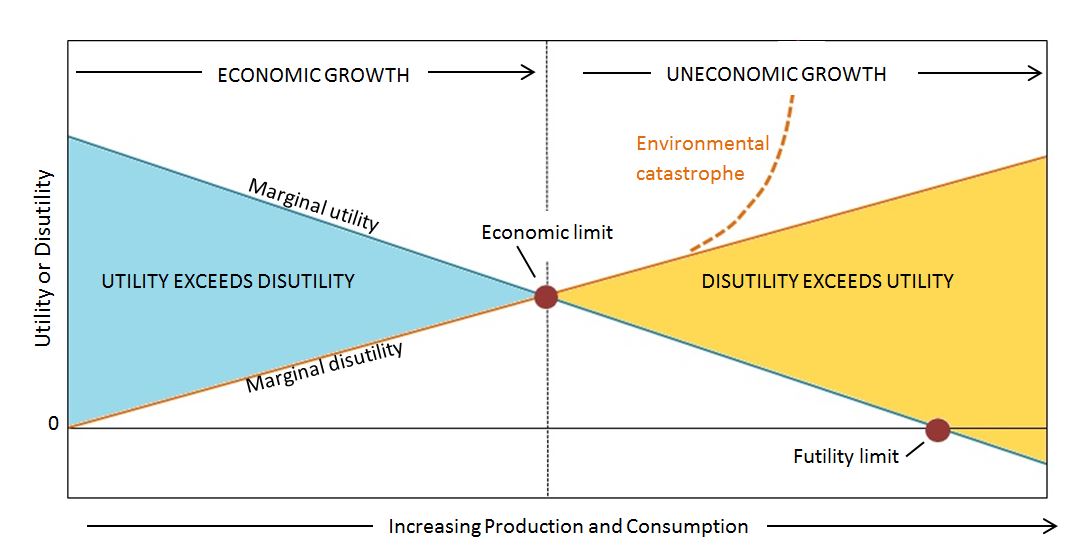
From the diagram, we can distinguish three concepts of limits to growth.
- The “futility limit” occurs when the marginal utility of production falls to zero. Even with no cost of production, there is a limit to how much we can consume and still enjoy it. There is a limit to how many goods we can enjoy in a given time period, as well as a limit to our stomachs and to the sensory capacity of our nervous systems. In a world with considerable poverty and in which the poor observe the rich apparently still enjoying their extra wealth, this futility limit is thought to be far away, not only for the poor but for everyone. By its “non satiety” postulate, neoclassical economics formally denies the concept of the futility limit. However, studies showing that beyond a threshold, self-evaluated happiness (total utility) ceases to increase with GDP, strengthen the relevance of the futility limit.
- The “ecological catastrophe limit” is represented by a sharp increase to the vertical of the marginal cost curve. Some human activity or novel combination of activities, may induce a chain reaction or tipping point, and collapse our ecological niche. The leading candidate for the catastrophe limit at present is runaway climate change induced by greenhouse gasses emitted in pursuit of economic growth. Where along the horizontal axis it might occur is uncertain. I should note that the assumption of a continuously and smoothly increasing marginal cost (disutility) curve is quite optimistic. Given our limited understanding of how the ecosystem functions, we cannot be sure that we have correctly sequenced our growth-imposed sacrifices of ecological services from least to most important. In making way for growth, we may ignorantly sacrifice a vital ecosystem service ahead of a trivial one. Thus the marginal cost curve might, in reality, zig-zag up and down discontinuously making it difficult to separate the catastrophe limit from the third and most important limit, namely the economic limit.
- The “economic limit” is defined by marginal cost equal to marginal benefit and the consequent maximization of net benefit. The good thing about the economic limit is that it would appear to be the first limit encountered. It certainly occurs before the futility limit and likely before the catastrophe limit, although as just noted that is uncertain. At worst the catastrophe limit might coincide with and discontinuously determine the economic limit. Therefore it is very important to estimate the risks of catastrophe and include them as costs counted in the disutility curve, as far as possible.
From the graph, it is evident that increasing production and consumption is rightly called economic growth only up to the economic limit. Beyond that point it becomes uneconomic growth because it increases costs by more than benefits, making us poorer, not richer. Unfortunately, it seems that we perversely continue to call it economic growth! Indeed, you will not find the term “uneconomic growth” in any textbook in macroeconomics. Any increase in real GDP is called “economic growth” even if it increases costs faster than benefits.
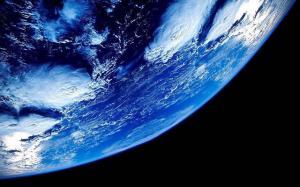
The macro-economy is not the Whole, but rather Part of the finite Whole. (Image: CC0, Credit: Beth Scupham).
Economists will note that the logic just employed is familiar in microeconomics—marginal cost equal to marginal benefit defines the optimal size of a microeconomic unit, be it a firm or household. That logic is not usually applied to the macro-economy, however, because the latter is thought to be the Whole rather than a Part. When a Part expands into the finite Whole, it imposes an opportunity cost on other Parts that must shrink to make room for it. When the Whole itself expands, it is thought to impose no opportunity cost because it displaces nothing, presumably expanding into the void. But the macro-economy is not the Whole. It too is a Part, a part of the larger natural economy, the ecosphere, and its growth does inflict opportunity costs on the finite Whole that must be counted. Ignoring this fact leads many economists to believe that growth in GDP could never be uneconomic.
Standard economists might accept this diagram as a static picture, but argue that in dynamic world technology, will shift the marginal benefit curve upward and the marginal cost curve downward, moving their intersection (economic limit) ever to the right, so that continual growth remains both desirable and possible. However, macroeconomic curve-shifters need to remember three things. First, the physically growing macro-economy is still limited by its displacement of the finite ecosphere and by the entropic nature of its maintenance throughput. Second, the timing of new technology is uncertain. The expected technology may not be invented or come on line until after we have passed the economic limit. Do we then endure uneconomic growth while waiting and hoping for the curves to shift? Third, let us remember that the curves can also shift in the wrong directions, moving the economic limit back to the left. Did the technological advances of tetraethyl lead and chlorofluorocarbons shift the cost curve down or up? How about nuclear power? Adopting a steady state economy allows us to avoid being shoved past the economic limit. We could take our time to evaluate new technology rather than letting it blindly push growth that may well be uneconomic. And the steady state gives us some insurance against the risks of ecological catastrophe that increase with growthism and technological impatience.
 Herman Daly is CASSE Chief Economist, Professor Emeritus (University of Maryland), and past World Bank senior economist.
Herman Daly is CASSE Chief Economist, Professor Emeritus (University of Maryland), and past World Bank senior economist.
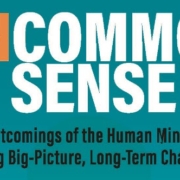

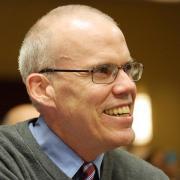
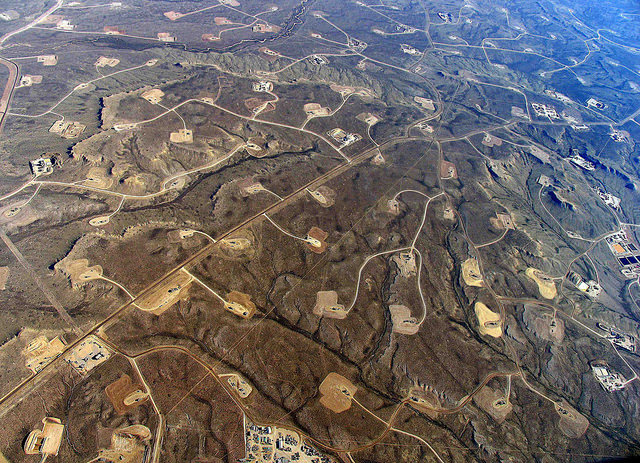


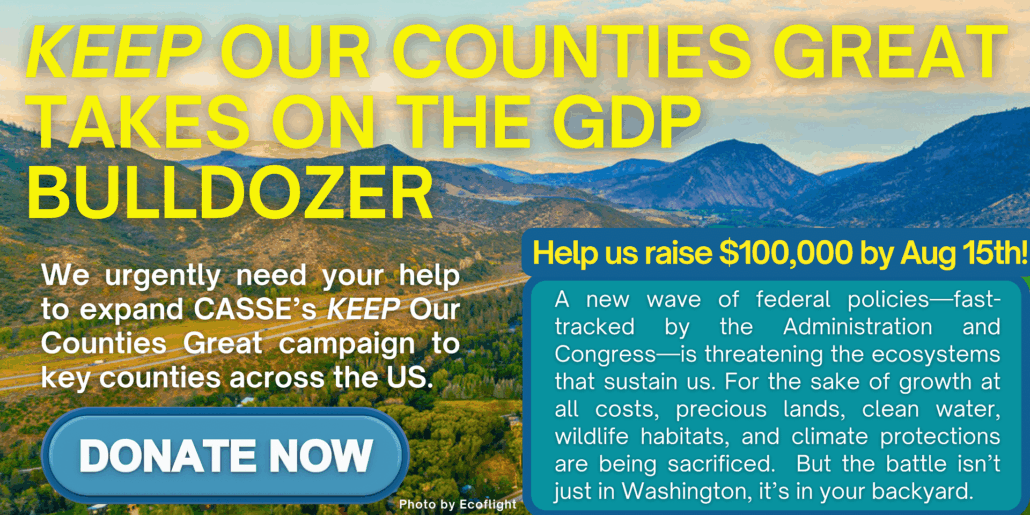
Excellent article; thank you. Both discerning and readable.
Professor Daly ignores the double exponential growth of science and knowledge. Today’s perceived problems will become tomorrows solutions. Perhaps to be replaced by new “problems” not yet perceived.Cheers, Werner
This is going right out to students in my “Political Economy for a Finite Planet” course, who are reading the Daly and Farley text among other things.
“uneconomic growth” -a term that must be inserted not only in our lexicon, but in our daily conversation, much and as often as possible until it penetrates mainstream thinking ….
Excellent article. I would only take issue with the assumption of global warming. We may in fact have catastrophic global cooling if the solar sun spot cycle people are correct . There is now significant debate among many scientists about this subject and the claims to massaged data etc. i am no climate scientist, but I think the global cooling school raises significant issues with thw highky politicized global warming camp. We are also surely to have catastrophic environmental issues with the depletion of many natural resources, for instance top soil, at a rate that exceeds replenishment. The question we must all ask ourselves, is what am I personally doing to change and respond to the errors implicit in over consumption and constant growth? What is my personal environmental foot print accounting for all in puts and out puts. ( i am sure mist on this site have read Heinberg’s excellent book, “Enough is Enough”). I am working in earnest towards being a better steward of this planet and of humanity. It is not enough to be a mere intellectual dillitante in these matters. We all must respond too. I do thank the CASSE writers for bring so much of this to my attention.
Excellent article – so succinct and makes so much sense, while also being a major insight.
In response to the comment before me (Sukey Jacobson) – the author only mentioned runaway climate change. The term “global warming” has largely been abandoned because scientists now think the climate will be warming in some places and cooling in others. That’s why we just use the term “climate change” now.
The indisputable “elephant in the room” is U.S. gasoline consumption.
At 9 mbd and 10.6 barrels/year/capita, this profligate, unique ( to the rest of the industrialized world) dissipation of finite oil slots right in 3’rd behind U.S. total oil at 19 mbd ( 22 barrels/year/capita) and China total oil of 10 mbd( 2 barrels/year/capita).
Regardless of everything else..population growth, water, food, climate change , etc. , this way of American life CANNOT continue for more than about 7 years without 50% foreign oil import, or 14 years with 50% foreign oil from a the rest of the world already fighting and collapsing over the remaining dregs at 3 barrels/year/capita.
FOCUS on U.S. gasoline! We’re running out and the entire American economy and way of life is about to end. “The Long Emergency” won’t be very long.
New thesis and 5’th ed. book “Is there a way forward?”. coming….if there’s still time. Don’t get too far from your garden and woodpile.
Excellent presentation… thank you.
I suggest referring to ‘DISeconomic’- rather than ‘UNeconomic’ growth, to emphasize its worse-than-neutral effects.